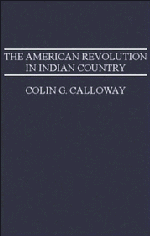Book contents
- Frontmatter
- Dedication
- Contents
- List of figures and maps
- Preface
- Acknowledgments
- Abbreviations
- Prologue New worlds for all: Indian America by 1775
- 1 Corn wars and civil wars: the American Revolution comes to Indian country
- 2 Odanak: Abenaki ambiguity in the North
- 3 Stockbridge: the New England patriots
- 4 Oquaga: dissension and destruction on the Susquehanna
- 5 Fort Niagara: the politics of hunger in a refugee community
- 6 Maquachake: the perils of neutrality in the Ohio country
- 7 Chota: Cherokee beloved town in a world at war
- 8 Tchoukafala: the continuing Chickasaw struggle for independence
- 9 Cuscowilla: Seminole loyalism and Seminole genesis
- 10 The peace that brought no peace
- Epilogue A world without Indians?
- Index
2 - Odanak: Abenaki ambiguity in the North
Published online by Cambridge University Press: 18 December 2014
- Frontmatter
- Dedication
- Contents
- List of figures and maps
- Preface
- Acknowledgments
- Abbreviations
- Prologue New worlds for all: Indian America by 1775
- 1 Corn wars and civil wars: the American Revolution comes to Indian country
- 2 Odanak: Abenaki ambiguity in the North
- 3 Stockbridge: the New England patriots
- 4 Oquaga: dissension and destruction on the Susquehanna
- 5 Fort Niagara: the politics of hunger in a refugee community
- 6 Maquachake: the perils of neutrality in the Ohio country
- 7 Chota: Cherokee beloved town in a world at war
- 8 Tchoukafala: the continuing Chickasaw struggle for independence
- 9 Cuscowilla: Seminole loyalism and Seminole genesis
- 10 The peace that brought no peace
- Epilogue A world without Indians?
- Index
Summary
The Revolution tolerated few neutrals. In time and in general, most Indian peoples came around to siding with the British, but in individual communities the situation was always more complex. A struggle that split non-Indian communities throughout the colonies generated similar repercussions in communities in Indian country, but not necessarily for the same reasons. The Abenakis at Odanak in Quebec had ties to other Indian communities in New England and Canada, and, via the Seven Nations confederacy, to the Iroquois in New York. They also occupied a key location on the Saint Lawrence River, which placed the community in a tug-of-war between the British in Quebec and the Americans in northern New England, both of whom regarded them with suspicion. The people of Odanak lacked consensus about what course to pursue in the Revolution, and Abenakis served in small-scale operations on both sides during the war. But beneath the surface confusion and ambivalence, all Abenakis at all times shared the goal of preserving their community and keeping the war at arm's length. All they disagreed on was the means to that end. Neutrality was a perilous strategy, more likely to make the village a target than a haven when British and Americans alike adhered to the notion that if Indians were not fighting for you they would fight against you. Many Abenakis opted instead for limited and sometimes equivocal involvement in the conflict. The family-band structure of Abenaki society meant that different people could espouse different allegiances without tearing the community apart. Individual participation on both sides, though limited and part of no master strategy, also allowed flexibility as the fortunes of war shifted. The Revolution would not leave the Abenakis alone, but they could divert it into less destructive channels.
Odanak, or Saint Francis, emerged as a mission village and refugee center in Quebec during the previous century.
- Type
- Chapter
- Information
- The American Revolution in Indian CountryCrisis and Diversity in Native American Communities, pp. 65 - 84Publisher: Cambridge University PressPrint publication year: 1995



